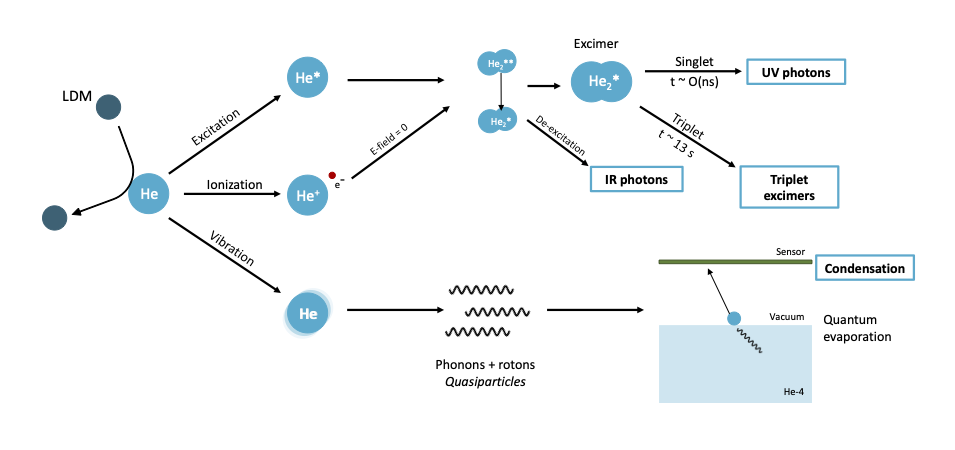The DELight Experiment
Superfluid Helium-4
 An example of the superfluid helium fountain effect. Photo provided by Prof. Dr. Christian Enss. At temperatures below 2.17K, helium-4 begins to behave as a fluid with zero viscosity, exhibiting several fascinating properties, including the tendancy to creep up solid surfaces and flow out of containers. One of the most dramatic properties is the so-called fountain effect, in which a thin tube or flask with a thin neck is inserted into a container of superfluid helium, and then heated. The bottom of the tube or flask is blocked with a material across which only the superfluid helium can flow. The helium in the tube is ejected, forming fountains as high as 30cm. An example of a superfluid helium fountain is shown on the right.
An example of the superfluid helium fountain effect. Photo provided by Prof. Dr. Christian Enss. At temperatures below 2.17K, helium-4 begins to behave as a fluid with zero viscosity, exhibiting several fascinating properties, including the tendancy to creep up solid surfaces and flow out of containers. One of the most dramatic properties is the so-called fountain effect, in which a thin tube or flask with a thin neck is inserted into a container of superfluid helium, and then heated. The bottom of the tube or flask is blocked with a material across which only the superfluid helium can flow. The helium in the tube is ejected, forming fountains as high as 30cm. An example of a superfluid helium fountain is shown on the right.
Why Superfluid Helium-4?
Superfluid helium-4 has several properties that make it an ideal target for searching for light dark matter (LDM).
- Low atomic mass
- No intrinsic long-lived radioisotopes
- All other contaminants freeze out, making it highly pure
- Relatively inexpensive compared to other target materials such as xenon
When a particle interacts in superfluid helium-4, the energy deposition causes a cascade of processes which culminate in the deposited energy being distributed between quasiparticles phonons and rotons, which are quanta of vibration, light (mostly ultraviolet and some infrared), and long-lived triplet excimersexcited molecules.

The partitioning of the energy between the different channels is dependent on whether the interaction is a nuclear recoil or an electron recoil; that is, whether the incident particle interacted with the nucleus or with electrons. It is therefore possible to discriminate electron recoils from nuclear recoils. This means that when searching for LDM-nucleus interactions, electron recoil backgrounds can be rejected.
Experimental Apparatus
 The first phase of the DELight experiment will consist of a 10L volume of superfluid helium instrumented by Magnetic MicroCalorimeter (MMC) detectors [1]. A schematic of the experimental setup is shown on the right. Above the superfluid helium volume is vacuum. Quasiparticles from particle interactions can liberate helium atoms at the helium surface in a process known as quantum evaporation. The atoms are subsequently detected by MMC detectors positioned above the liquid surface.
The first phase of the DELight experiment will consist of a 10L volume of superfluid helium instrumented by Magnetic MicroCalorimeter (MMC) detectors [1]. A schematic of the experimental setup is shown on the right. Above the superfluid helium volume is vacuum. Quasiparticles from particle interactions can liberate helium atoms at the helium surface in a process known as quantum evaporation. The atoms are subsequently detected by MMC detectors positioned above the liquid surface.
The cryogenic temperatures of 10 mK will be achieved using a dilution refrigerator, which uses the heat of mixing of the isotopes 3He and 4He to provide cooling power.
One significant challenge which must be mitigated results from the property of superfluid helium to creep up walls as a thin film. Eventually, it would reach the detectors above the liquid volume and reduce their sensitivity. To avoid this problem, DELight will implement film burners, which use heated baffles (shown in red).
MMCs comprise a particle absorber and a paramagnetic temperature sensor, which is placed in a weak magnetic field, creating a temperature dependent magnetization. When a particle interacts in the absorber there is a resulting temperature increase. The sensor, which is in close thermal contact with the absorber, also increases in temperature, causing a change in magnetization which can be very precisely measured as a change of magnetic flux using a superconducting quantum interference device (SQUID). These wafer calorimeters can achieve exceptional energy resolution: a resolution of 1.3 eV for 6 keV X-rays has previously been demonstrated [2,3]. For DELight, we also expect eV-scale energy resolution, leading to an energy threshold of 10-20 eV. The first phase of DELight will use 50 large-area MMC-based wafer calorimeters with high purity silicon or sapphire wafers as a substrate. One fifth of the wafer calorimeters will be placed above the liquid helium for detecting the evaporated helium atoms as well as UV photons, and the remaining wafer calorimeters will be submerged in the superfluid also to measure UV photons as well as the long-lived triplet excimers. The figure to the right shows sensitivity curves for DELight based on increasing exposurethe detector target mass multipled by the cumulative time during which the detector is operational and actively searching for dark matter and improved energy thresholds, demonstrating the potential parameter space that could be excluded. These sensitivity curves are preliminary estimates which assume zero background. The neutrino signal regionthe point at which a dark matter signal could not be distinguished from a neutrino signal in He, calculated as in Ref. [4], and parameter space already excluded by CRESST [5], DarkSide-50 [6], and XENON-1T [7,8] are also shown.Magnetic MicroCalorimeters
Dark Matter Sensitivity
 Plot produced June 2022 An important parameter space for dark matter searches is the interaction strength vs. dark matter mass plane. Such plots can show discovery potential, or demonstrate constraints set by the non-detection of dark matter. Much of the spin-independent nuclear scattering cross-section parameter space has already been excluded, particularly for dark matter with masses higher than 10 GeV/c2.
Plot produced June 2022 An important parameter space for dark matter searches is the interaction strength vs. dark matter mass plane. Such plots can show discovery potential, or demonstrate constraints set by the non-detection of dark matter. Much of the spin-independent nuclear scattering cross-section parameter space has already been excluded, particularly for dark matter with masses higher than 10 GeV/c2.
References
[2] M. Krantz, F. Toschi, B. Maier, G. Heine, C. Enss, and S. Kempf, Magnetic microcalorimeter with paramagnetic temperature sensors and integrated dc-SQUID readout for high-resolution X-ray emission spectroscopy, Applied Physics Letters 124 (2024) 032601
[3] F. Toschi, B. Maier, G. Heine, T. Ferber, S. Kempf, M. Klute, and B. von Krosigk, Optimum filter-based analysis for the characterization of a high-resolution magnetic microcalorimeter towards the DELight experiment, arXiv:2310.08512 (2023)
[4] F. Ruppin, J. Billard, E. Figueroa-Feliciano and L. Strigari, Complementarity of dark matter detectors in light of the neutrino background, Phys. Rev. D 90, 083510 (2014)
[5] A. H. Abdelhameed et al., First results from the CRESST-III low-mass dark matter program, Phys. Rev. D 100, 102002 (2019)
[6] P. Agnes et al., Low-mass dark matter search with the DarkSide-50 Experiment, Phys. Rev. Lett. 121, 081307 (2018)
[7] E. Aprile et al., Dark matter search results from a one ton-year exposure of XENON1T, Phys. Rev. Lett. 121, 111302 (2018)
[8] E. Aprile et al., Search for coherent elastic scattering of solar 8B neutrinos in the XENON1T dark matter experiment, Phys. Rev. Lett. 126, 091301 (2021)
